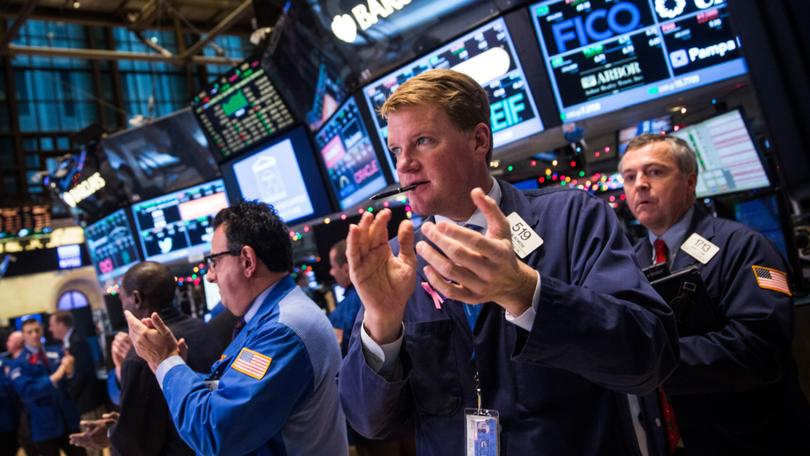ASX market updates: Australian shares on a tear as Donald Trump’s tariffs pause eases investor pain

Australian shares have skyrocketed after US President Donald Trump declared a 90-day tariff pause for many countries, bringing some relief to investors worried about the global economic impact of US trade policies.
The local rally will be welcomed by investors who have endured a gut-wrenching week of market chaos since Mr Trump outlined his so-called “Liberation Day” reciprocal tariffs last week.
But in the US overnight, Mr Trump said he would temporarily lower many new tariffs, but raised the levy on imports from China to 125 per cent.
Sign up to The Nightly's newsletters.
Get the first look at the digital newspaper, curated daily stories and breaking headlines delivered to your inbox.
By continuing you agree to our Terms and Privacy Policy.The pause on tariffs for dozens of trading partners came less than 24 hours after they kicked in.
The S&P-ASX200’s rally started slow, with a tentative gain of just 1.4 per cent in the first few minutes of trade but gathered momentum to climb about 6 per cent to 7806.4 points by 8.20am — the highest point for the week so far, and only 128 points off the mark before Mr Trump reignited a global trade war.
The index is still off 2.2 per cent for the past month and 5 per cent for the year so far.
But the euphoria faded later in the session, but it was still up 4.8 per cent to 7725.3 at 10.15am.
All 11 sectors were in the green, with IT stocks leading the charge with a 6.9 per cent gain, followed by real estate (up 6.2 per cent), miners (up 6 per cent), energy (up 5.5 per cent), consumer discretionary (up 4.9 per cent), banks (up 4.6 per cent), and health care (up 3.6 per cent).
Among the big miners, Fortescue soared 5.9 per cent to $15.04, Rio Tinto was up 5.7 per cent to $109.87 and BHP added 6.4 per cent to $36.35.
Chris Ellison’s Mineral Resources erased Wednesday rout to climb 13.6 per cent to $16.36.
But while many will be celebrating the rebound, Aussie investors will still fret the fallout ahead for the Middle Kingdom.
The increase in tariffs for Beijing was in retaliation to China’s announcement of a levy of 84 per cent on US goods starting April 10.
While Trump’s announcement still left investors with uncertainty about his ultimate tariff policy, traders took the opportunity to shop for beaten-down stocks. Since Mr Trump announced broad tariffs late on April 2, stocks had fallen more than 12 per cent, for their biggest four-day selloff in five years.
“Markets had been looking for a reason to rally for a few days. Markets can only sustain extreme conditions for so long before exhaustion sets in, rather like a toddler and a tantrum,” said Carol Schleif, chief market strategist at BMO Private Wealth in Minneapolis.
“The 90-day suspension does allow nice breathing room to allow negotiation to settle in and market valuations have clearly been reset. Yet the uncertainty for companies remains.”
After Mr Trump’s reversal, Goldman Sachs said it was rescinding its recession forecast and reverting to its previous baseline estimate for the economy to grow in 2025.
US stock market indices rocketed sharply higher on Mr Trump’s announcement, reversing four days of losses. The S&P 500 index leapt by 7 per cent, which puts it on track for its largest single-day gain in five years.
“We are living minute-to-minute,” said Eric Diton, president and managing director at Wealth Alliance.
“There was a whole bunch of petrified people out there trying to grasp at something positive,” he said. “I don’t think this is the bottom, that can’t be called until we see actual deals signed.”
When asked later about the reason for his decision, Mr Trump told reporters: “Well, I thought that people were jumping a little bit out of line.”
“They were getting yippy, you know, they were getting a little bit yippy, a little bit afraid,” Mr Trump said at the White House.
Treasury Secretary Scott Bessett claimed to reporters that Mr Trump had always intended to put the brakes on the wide-ranging tariffs the president announced last week.
How long can the euphoria last?
Morningstar’s US economist Preston Caldwell said the market’s reaction was too optimistically, “unless Trump announces further tariff reductions and credibly refrains from future retaliatory increases”.
“The tariff relief that President Donald Trump announced on Wednesday came somewhat quicker than expected,” Mr Caldwell said.
“However, we already anticipated that the average US tariff rate would decline from 25 per cent at the time of the April 2 announcement to 18 per cent by year-end 2025.
“We’ll make some tweaks to our economic forecast, but we still expect a major rise in inflation, slowing economic growth, and a roughly 40 per cent risk of a recession this year.”
But there could be better news ahead for homeowners.
National Australia Bank forecasts the Reserve Bank will slash the cash rate by 50 basis points next month, with 25 point cuts in July, August, November and February.
“Headwinds from the global environment have intensified, but error bounds around our forecast are large given uncertainty remains exceptionally elevated,” NAB chief economist Sally Auld said in a note.
